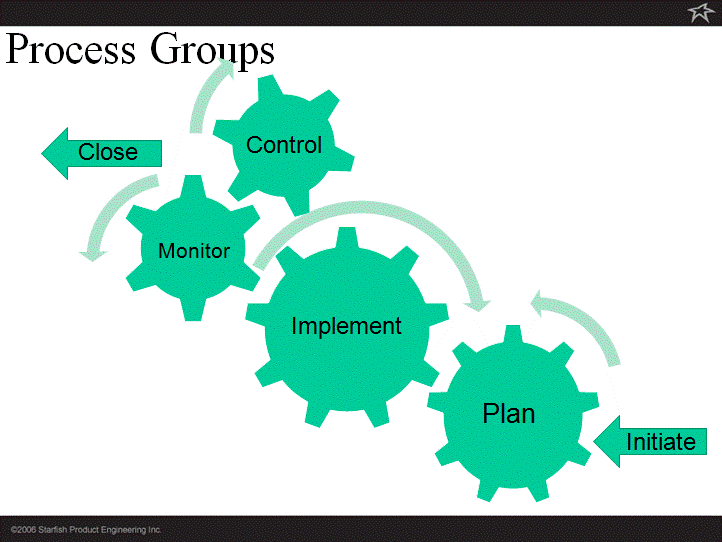
ISO 21500 and Medical Device Development
The first edition of ISO 21500 Guidance on Project Management was published in September. Prior to the publication of ISO 21500, project management practice was guided by the Project Management Institute (PMI®), an international not-for-profit professional association with over 700,000 members and volunteers advocating for the project management profession and responsible for the project management professional (PMP) certification program.
The new ISO 21500 standard is very much in line with the PMI guide. This blog discusses some areas of the ISO 21500 that slightly diverge from the PMI established guidance and my experiences implementing the standard as Project Management Officer in the Project Management Office (PMO) at StarFish Medical.

The PMI “knowledge areas” are called ”subject groups” in ISO 21500, but essentially refer to the same grouping of integration, scope, time, cost, risk, quality, human resources, procurement, communication and stakeholder. For the longest time, PMI through its Project Management Book of Knowledge (PMBoK®) promoted nine knowledge areas to ensure that all aspects of a project were addressed. These areas needed to be processed in a sequential manner from initiation, planning, execution, monitoring and control and closing.
The ISO Standard recommends a 10th knowledge area called Stakeholder Management. The stakeholder subject group is effectively an extension of the communication knowledge area for external communication, primarily with a focus of analyzing stakeholders’ influence and positions on a particular project and managing their concerns and wishes. This latest division of the communication knowledge area (or differentiation between internal and external communication) was reflected in the PMBoK® 5th Edition.
ISO 21500 emphasis on project deliverables that exist to advance business goals
“The organization strategy identifies opportunities. The opportunities are evaluated and should be documented. Selected opportunities are further developed in a business case or other similar document, and can result in one or more projects that provide deliverables. Those deliverables can be used to realize benefits. The benefits can be an input to realizing and further developing the organizational strategy”.[1]
This is a clear reminder to our Project Engineers that their projects are all about clients’ business objectives, more precisely the development and realization of medical device concepts into manufacturable and commercially viable products.
Another interesting evolution of the implementation of the ISO 21500 standard in project management practice is an emphasis on “controlling” as opposed to “planning” that seemed prevalent in PMI publications. The ISO standard clearly advocates maximizing the positive while minimizing the negative project impacts to control the project work, scope, changes, risks, resources, schedule and costs. There is an underlying requirement to constantly compare to baselines and justify any deviations.
The quality subject group is very well defined and includes quality planning activities, quality assurance and quality control. A reminder for those who confuse quality assurance and quality control; the former entails setting up corporate or project-wide systems to support quality requirements and the later relates to the systematic review of a product against requirements, typically using a checklist.
StarFish’s Corrective and Preventive Action (CAPA) system is a good example of quality assurance: it is a system accessible to all company personnel and contractors so they can report any shortfall in current product development and manufacturing processes and/or suggest improvements for performance and efficiency.
The important thing to remember in reviewing and adopting a systematic project management approach that has clearly defined processes and subject groups is that they are not prescriptive, but simply recommended. The ISO Standard is a guideline only, but one that has been proven across cultures, over various industries and types of projects, from the very technical to more subjective policy development project and irrespective of project complexity, duration, size or budget.
The advantage of using an ISO standard to reinforce good PM practice in the medical device development
Project Managers and team members are all very familiar with the importance of implementing and conforming to standards. Medical Device industry is highly regulated: ISO 13485 Medical Devices Quality Management Systems (similar to 21 CRF Part 820 as recognized by FDA) established the development environment and any designer must conform to a strict design control standard operating procedure (SOP).
There are 22 SOPs at StarFish and product designers must be able to show full documentation traceability concept to manufacturing. Any design engineer daring to deviate from the prescribed design control process pays a premium by having to redevelop documentation in support of their design in a retrospective manner (much more difficult than going forward). “Reverse documentation engineering” can be very costly.
The PMO is the primary vehicle to distribute knowledge around project management practice and support Project Managers in their day to day management throughout the life cycle of their projects. In addition to its governance and PM standardization role, the PMO coordinates and delivers PM training, assists in project planning and performs project monitoring. As the Project Management Officer at StarFish, I bring new trends, knowledge and standards so we continuously improve our practice.
I am confident that the deployment of ISO 21500 will go smoothly and I will not need to use my title of “Officer” to enforce it; our Project Managers comply with other standards (design control) that are much more challenging. I’d love to hear about examples from readers on how ISO21500 has impacted their Project Management and Medical Product Development.
[1] ISO 21500:2012(E) Guidance on Project Management/Ligne Directrices sur le Management de Projet, First Edition, ISO, Section 3 (2)
Martine Janicki led the PMO at StarFish Medical and holds a PhD, PEng and a PMP certification. Please visit our Medical Product Development page for more information on how Project Management plays a key role at StarFish Medical.
Images: StarFish Medical